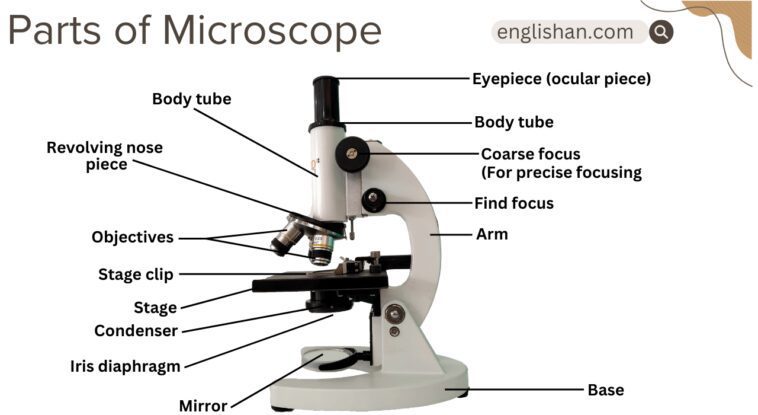A microscope is an optical tool that magnifies small objects for detailed observation. It is widely used in scientific fields like biology, medicine, and materials science.
What is the Microscope?
A microscope is a special tool that helps us see tiny things that our eyes can’t catch on their own. It works by using lenses and light to make small objects look much bigger. This helps scientists and researchers study very small details, like cells or tiny organisms.
Types of Microscopes
1. Compound Microscope:
- Multiple lenses magnify specimens (40x to 1000x).
2. Stereo:
- Provides a 3D view at lower magnifications (used for larger objects).
3. Electron:
- Uses electrons for ultra-high magnification and resolution.
4. Confocal:
- Produces 3D images using laser light.
5. Fluorescence:
- Highlights specific structures using fluorescent dyes.
Main Components
1. Eyepiece:
- Where you look through the microscope.
2. Objective Lenses:
- Magnification lenses closest to the specimen.
3. Stage:
- Platform for placing specimens.
4. Illuminator:
- Light source directing light through the specimen.
5. Condenser:
- Lens system improving light focus.
6. Diaphragm:
- Controls light reaching the specimen.
7. Adjustment Knobs:
- Coarse and fine knobs for focusing.
8. Nosepiece:
- Holds multiple objective lenses.

What are the Main Parts of the Microscope?
The main parts of a microscope can be categorized into several key components. Here’s a breakdown of the main parts of a compound microscope:
1. Eyepiece (Ocular):
- The lens you look through, usually with 10x magnification.
2. Objective Lenses:
- Lenses near the specimen, providing different magnification levels (e.g., 4x, 10x, 40x, 100x).
3. Nosepiece (Revolving Turret):
- A rotating structure holding the objective lenses, allowing for easy switching between them.
4. Stage:
- The platform where the specimen is placed for observation.
5. Stage Clips:
- Clips to secure the specimen in place on the stage.
6. Coarse Adjustment Knob:
- The large knob used for initial, rapid focusing.
7. Fine Adjustment Knob:
- The smaller knob for precise focusing.
8. Illuminator:
- The light source (typically located beneath the stage) that illuminates the specimen.
9. Diaphragm:
- A rotating disk under the stage with different-sized openings, controlling the amount of light passing through the specimen.
10. Condenser:
- Lens system beneath the stage that focuses light onto the specimen.
11. Rack and Pinion:
- Mechanism for moving the stage up and down, controlled by the coarse adjustment knob.
12. Base:
- The bottom part of the microscope, providing stability and support.
13. Arm:
- Connects the head and base, often used as a handle for carrying the microscope.
14. Tube (Head):
- The vertical part that holds the eyepiece and connects it to the objective lenses.
15. Coarse and Fine Adjustment Knobs:
These knobs control the focus of the microscope. The coarse adjustment is used for initial focusing, while the fine adjustment allows for precise focusing.
What are the Main Functions?
The main function of a microscope is to magnify and resolve small or microscopic objects, making them visible to the human eye. The microscope achieves this by using a combination of lenses and an illumination system to enhance the details of specimens that are too small to be seen with the naked eye. The primary goals of a microscope are as follows:
1. Magnification: Microscopes magnify specimens, allowing users to see details that are not visible without assistance. Magnification is achieved through the use of objective lenses and eyepieces.
2. Resolution: Microscopes enhance the resolution of specimens, enabling the viewer to distinguish fine details and structures. Higher magnification often leads to improved resolution.
3. Illumination: Microscopes incorporate a light source (illuminator) to illuminate the specimen. Proper illumination is crucial for creating a clear and visible image.
4. Observation and Analysis: Microscopes are used for the observation and analysis of various specimens, including cells, microorganisms, tissues, crystals, and other small objects. They are essential tools in biological, medical, and scientific research.
5. Scientific Discovery: Microscopes have played a pivotal role in scientific discovery, enabling researchers to explore the microscopic world and make groundbreaking observations. They have contributed significantly to our understanding of biology, medicine, materials science, and other fields.
How to Buy a Microscope
Buying a microscope can be a rewarding investment for scientific research, education, or personal exploration. Here’s a guide on how to buy a microscope:
1. What is a microscope?
A microscope is an optical instrument that magnifies small objects or specimens, allowing detailed observation of structures not visible to the naked eye.
2. How does a microscope work?
Microscopes use lenses to bend and magnify light, enabling the viewer to see small details. They may have various types of lenses and illumination systems.
3. What are the different types of microscopes?
Common types include compound microscopes, stereo microscopes, electron microscopes, confocal microscopes, and fluorescence microscopes.
4. What is the magnification of a microscope?
Magnification refers to how much larger an object appears compared to its actual size. It’s determined by the eyepiece and objective lens combination.
5. What is the resolution of a microscope?
Resolution is the ability to distinguish two closely spaced objects. Higher resolution allows for clearer and more detailed imaging.
6. How do I choose the right microscope for my needs?
Consider your intended use, required magnification, and the type of specimens you’ll be observing. Factors like illumination, optics quality, and budget are also important.
7. How do I clean and maintain a microscope?
Use lens paper to clean lenses, avoid touching optics with fingers, and store in a dust-free environment. Regular maintenance includes checking and adjusting the focus mechanisms.
You May Also Like:



